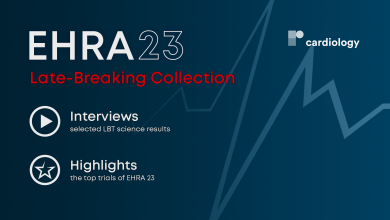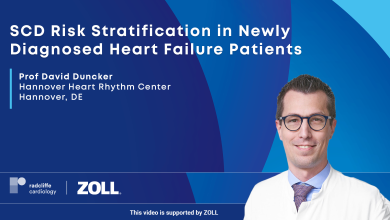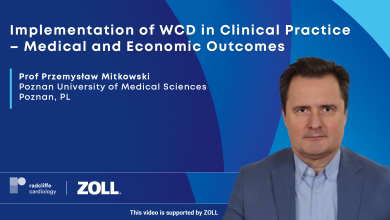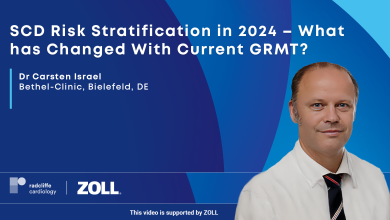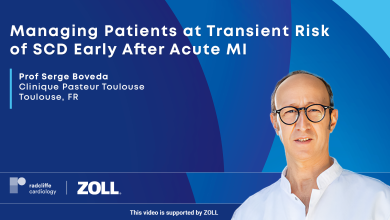In This Section:
Sudden Cardiac Death
Proven Therapy for Patients at Early Risk of Sudden Cardiac Death
The risk of sudden cardiac death (SCD) or life threatening arrhythmias is notably elevated in patients with newly diagnosed heart failure and reduced ejection fraction in the first 90 days after diagnosis.1,2 Clinical trials have shown that the clinical condition of patients often fluctuates during this period.3 Therefore, optimised guideline recommended medical therapy (GRMT) is crucial before considering further long-term therapies such as implantable cardioverter defibrillator (ICD) implantation.4-5 This reflects the outcome of recent clinical trials, that Reverse Remodeling processes take time despite modern drug therapy.6-7
Left-ventricular ejection fraction (LVEF) remains the most relevant predictor of SCD risk.1 According to the most recent guidelines from the European Society of Cardiology (ESC), patients with an LVEF ≤ 35% after an acute cardiac event could be considered for a wearable cardioverter defibrillator (WCD; LifeVest® ZOLL CMS) during the drug therapy optimisation phase.4-5,8 This recommendation is consistent with previous guidelines and is supported by extensive evidence, including data from over 20,000 patients from both retrospective and prospective registries, along with findings from large randomised controlled trials, highlighting the clinical effectiveness of the WCD in terminating ventricular tachyarrhythmias.1,7-13 The median WCD daily wearing time in recent studies and registries exceeds 22 hours.9-15
LifeVest WCD serves as a treatment option for patients with transient risk of SCD, offering advanced protection and monitoring during the early post-cardiac event phase while medical therapy is optimised and permanent risk is assessed. Unlike an ICD, LifeVest is worn outside the body rather than implanted in the chest. It is designed to continuously monitor a patient’s heart, detecting certain life-threatening rapid heart rhythms and automatically deliver a treatment shock to restore normal heart rhythm.

Section Advisor
Prof Christian Perings
The Sudden Cardiac Death section is supported by ZOLL

Video Series
Marco Bergonti, Bruce Wilkoff, Carlo Pappone, et al
Mario D Bassi , Juan M Farina , Jorge Bombau , et al
Recent Videos
Video
Video
Video
Video
Video
Video
Clinical publications
Elbayomi M, Weyand M, Seitz T, Harig F. Ann Noninvasive Electrocardiol 2023;28:e13048.
Buia V, Ciotola F, Bastian D, et al. Open Heart 2024;11:e002597.
Lai M, Cheung CC, Olgin J, et al. Am J Cardiol 2023;187:18–25.
Abumayyaleh M, Dreher TC, Rosenkaimer S, et al. J Cardiovasc Electrophysiol 2022;33:2243–9.
Goldenberg I, Younis A, McNitt S, et al. J Cardiovasc Electrophysiol 2024;35:785–93.
Udell JA, Petrie MC, Jones WS, et al. J Am Coll Cardiol 2024;83:2233–46.
Healey JS, Krahn AD, Bashir J, et al. Ann Intern Med 2022;175:1658–65.
Thomas KL, Al-Khatib SM, Kosinski AS, et al. Ann Intern Med 2023;176:615–23.
Ra J, Oberdier MT, Suzuki M, et al. Ann Intern Med 2023;176:289–97.
Perera D, Morgan HP, Ryan M, et al. Circulation 2023;148:862–71.
Wang J, Yang S, Ma X, et al. Eur Heart J 2023;44:4781–92.
Karacan MN, Doi SN, Yafasova A, et al. Eur J Heart Fail 2024;26:1423–31.
El-Battrawy I, Tenbrink D, Kovacs B, et al. Eur J Clin Invest 2023;53:e13977.
Mebazaa A, Davison B, Chioncel O, et al. Lancet 2022; 400:1938–52.
Veltmann C, Duncker D, Doering M, et al. Eur Heart J 2024; epub ahead of press.
Guidelines
Krieger EV, Zeppenfeld K, DeWitt ES, et al. Circ Arrhythm Electrophysiol 2022;15:e000084.
Korthals D, Eckardt L. Herzschrittmacherther Elektrophysiol 2023;34:311–23.
Brignole M, Cecchi F, Anastasakis A, et al. Int J Cardiol 2023;370:330–7.
Goette A, Lip GYH, Gorenek B. Eur Heart J Acute Cardiovasc Care 2023;12:62–8.
Lambiase PD, Maclean E. Heart 2024;110:313–22.
Casolo G, Gulizia MM, Aschieri D, et al. G Ital Cardiol (Rome) 2023;24:394–411.
Davies RA, Ladouceur VB, Green MS, et al. Can J Cardiol 2023;39:1285–301.
Könemann H, Dagres N, Merino JL, et al. Europace 2023;25:euad091.
Arbelo E, Protonotarios A, Gimeno JR, et al. Eur Heart J 2023;44:3503–626.
Radcliffe Content
US Cardiology Review 2024;18:e12.
US Cardiology Review 2024;18:e09.
Arrhythmia & Electrophysiology Review 2024;13:e11.
Interventional Cardiology 2024;19:e06.
Interventional Cardiology 2023;18:e29.
Arrhythmia & Electrophysiology Review 2023;12:e27
Arrhythmia & Electrophysiology Review 2023;12;e17.
Arrhythmia & Electrophysiology Review 2023;12:e10.
Interventional Cardiology 2023;18:e11.
Review Articles
Aidelsburger P, Seyed-Ghaemi J, Bonderman D. Int J Technol Assess Health Care 2023;39:e1.
Seferović PM, Polovina M, Rosano G, et al. Eur J Heart Fail 2023;25:1899–922.
Chrispin J, Merchant FM, Lakdawala NK, et al. J Am Coll Cardiol 2023;82:735–47.
Bessière F, Waldmann V, Combes N, et al. J Am Coll Cardiol 2023;82:1108–20.
Michelland L, Murad MH, Bougouin W, et al. Eur Heart J 2023;44:180–92.
Leyva F, Israel CW, Singh J. Circulation 2023;147:759–67.
Israel C, Staudacher I, Leclercq C, et al. Clin Res Cardiol 2022;111:1189–97.






